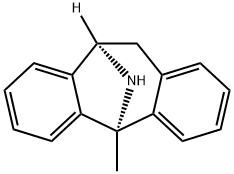77086-21-6
 77086-21-6 結(jié)構(gòu)式
77086-21-6 結(jié)構(gòu)式
基本信息
地佐環(huán)平
Dizocilpine
MK-801 (Dizocilpine)
Dizocilpine USP/EP/BP
Dizocilpine free base(MK801)
(5S)-5-Methyl-10,11-dihydro-5H-dibenzo[a,d]cyclohepten-5α,10α-imine
5H-Dibenzo[a,d]cyclohepten-5,10-imine, 10,11-dihydro-5-methyl-, (5S,10R)-
[5S,10R,(+)]-10,11-Dihydro-5-methyl-5H-dibenzo[a,d]cyclohepten-5,10-imine
[5S,10R,(+)]-10,11-Dihydro-5-methyl-5H-dibenzo[a,d]cyclohepten-5α,10α-imine
物理化學(xué)性質(zhì)
| 報(bào)價(jià)日期 | 產(chǎn)品編號(hào) | 產(chǎn)品名稱(chēng) | CAS號(hào) | 包裝 | 價(jià)格 |
| 2025/02/08 | HY-15084B | 地佐環(huán)平 Dizocilpine | 77086-21-6 | 5 mg | 300元 |
| 2025/02/08 | HY-15084B | 地佐環(huán)平 Dizocilpine | 77086-21-6 | 10 mM * 1 mLin DMSO | 330元 |
| 2025/02/08 | HY-15084B | 地佐環(huán)平 Dizocilpine | 77086-21-6 | 10 mg | 480元 |
常見(jiàn)問(wèn)題列表
Ki: 37.2 nM (NMDA receptor, in rat brain membrane)
Dizocilpine (MK-801) progressively suppresses of current induced by NMDA. Mg
2+
(10 mM) prevents Dizocilpine from blocking the N-Me-D-Asp-induced current, even when Dizocilpine is applied for a long time in the presence of NMDA. Dizocilpine blocks NMDA-activated single-channel activity in outside-out patches.
Dizocilpine (MK-801; <500 μM) inhibits activation of microglia induced by LPS with increased Cox-2 protein expression in BV-2 cells. Dizocilpine (<500 μM) reduces microglial TNF-α output with an EC
50
of 400 μM in BV-2 cells.
Dizocilpine (MK 801) (1 mg/kg) treatment before each METH injection reduces the extent of DA depletion by 55% in striatal of mice. Dizocilpine (MK 801) (1 mg/kg) also attenuates the effects of METH on microglial activation in striatal of mice.
Dizocilpine ((+)-MK 801) (0.05, 0.2 mg/kg, i.p.) attenuates subsequent cocaine-primed reinstatement without disruption in rats. Dizocilpine (MK 801) (0.2 mg/kg, i.p.) prior to two reactivation sessions in the home cage shows no suppression on subsequent cocaine-primed reinstatement.
Dizocilpine (0.03, 0.1, 0.3 and 1 mg/kg, i.p.) significantly increases the ambulation of mice at 0.3 and 1 mg/kg, but not at 0.03 and 0.1 mg/kg.